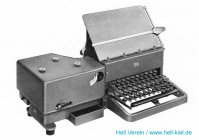| Key Punch TL 1 (1950) | ||||||
|
For a long time the transfer speed for Morse communication was dependent on the performance of the operator to key in the Morse codes. The speed was enhanced by using Morse transmitters, which read the Morse codes to be transmitted from a punched paper tape. These tapes were prepared with a key punch, where the text was typed in, transformed into the appropriate Morse codes, and punched into a paper tape, called Wheatstone tape (after the British Physicist Charles Wheatstone, 1802-1875).
|
||||||
|
A Wheatstone tape is a two channel tape with a row of feed holes in between. A dot of the Morse Code is punched as two holes one above the other, and a dash of the Morse code is punched as two holes separated by one punching position.
|
||||||
 |
||||||
|
A key stroke is transformed into the corresponding Morse code by a purely mechani-cal arrangement of levers and selection bars, which are shifted by means of recesses, in order to set the punching mechanism for the appropriate Morse code. The punch-ing mechanism is driven by an electrical motor. |
||||||
|
Catalogue ; 1962 ; 4 pages ; 1,1 MByte ; German
Catalogue ; 1974 ; 4 pages ; 916 KByte ; German
|
||||||
|
||||||

